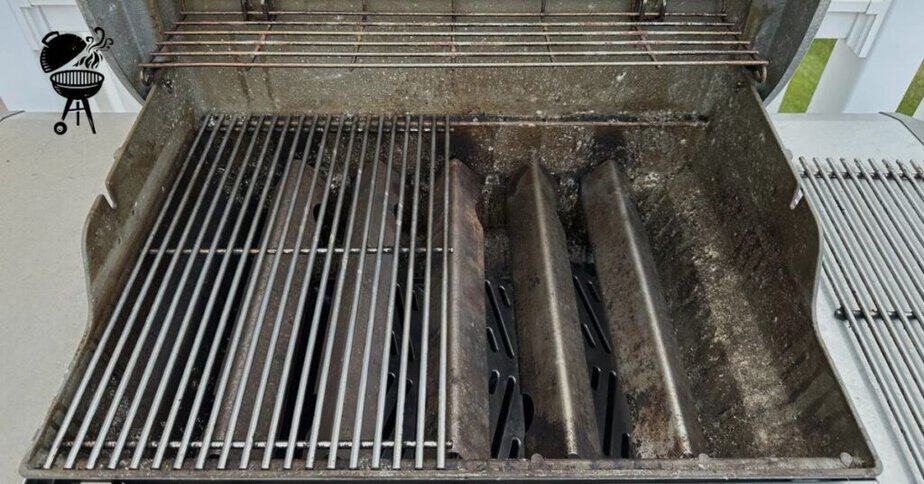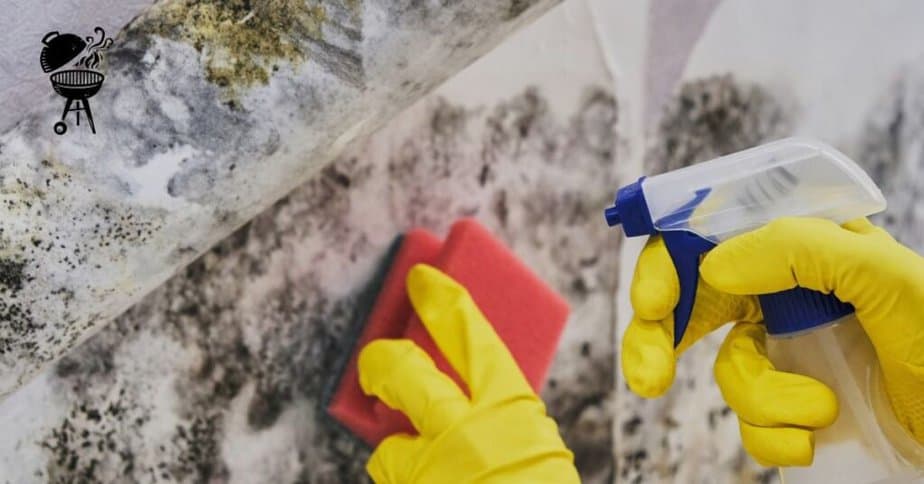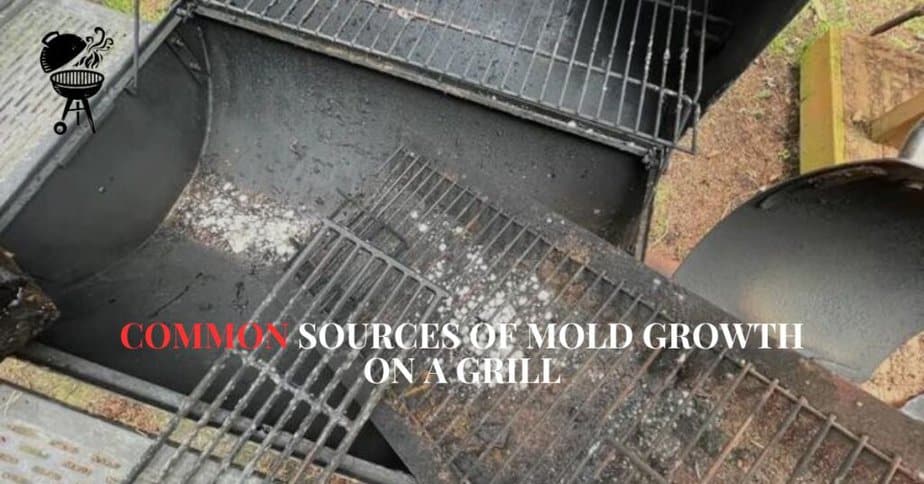A grill is considered as a best friend to most of the people. It makes delicious and healthy food easily by removing the fats from the meat. You can enjoy steaks and other dishes prepared on the grill with your loved ones. The issue arises when you don’t clean your grill before storing it. The grill feeds the fungus and you will see the molds grown inside the grill. Such conditions will ruin the gathering and you will be unable to enjoy the time.
Mold loves moist environments, so if you leave your grill unattained you will get molds. It is necessary to clean the grill and dry them completely before storing it, to avoid such conditions. No doubt mold on a grill is dangerous and today we will be reviewing the source of mold, and best practices to clean and prevent mold in maintaining your grill.
Is Mold on a Grill Dangerous?
Yes, it is a fungus that reproduces very fast through spores in the surrounding areas. The presence of mold spores in the air can cause respiratory problems and trigger wheezing and coughing. When the spores are inhaled, infectious diseases can spread to the body. The impairment occurs in the respiratory tract when the body reacts to the spores entering the lungs.
Mold exposure can cause hypersensitive responses in sensitive people with low immune systems or persistent lung sicknesses. When the body’s immune system reacts to mold spores, the reaction causes skin rashes, wheezing, runny nose, and red eyes. These spores may result in mild infections that may progress to more serious ones that necessitate medical attention. Mold spores exceptionally impact patients with asthma or chronic obstructive aspiratory disease.
Common Sources of Mold Growth on a Grill
Weather condition
When the outdoor grills are exposed to wet, and dark environments mold can grow in them. Rain, humidity, and dews can create perfect conditions for molds, particularly the chances get increased when the barbecue isn’t covered or safeguarded from the open climate. Keeping your barbecue dry and covered when not being used decreases the possibility of the development of molds.
Food and Fat Build-up
Oil and fat that gather on the barbecue over the long run can also contribute to mold growth. These substances can trap water and provide suitable conditions for the molds to grow. The oil, water, and food particles are a great source of nutrients for the mold spores.
The mold nourishes these particles and causes the grill to rust with the passage of time if you don’t use it. Therefore, it is necessary to clean the grill thoroughly and remove the grease and fat build-ups after grilling, or else your grill will get a grease fire.
Inadequate Cleaning
Improper cleaning of the barbecue after use is a typical reason for mold growth. Simply getting over the meshes isn’t sufficient; a more careful cleaning is important to remove all the food particles, oil, and other residues that can help in growing mold on a grill. A deep and regular cleaning can minimize the possible conditions for mold growth. Some gas grills come with an advanced grease management system.
Improper Storage
When the grill is not stored properly then mold can grow on your grill. If the grill is left in the open air where the climate is not good like it’s raining or there is humidity in the air, there is a lot more chance for molds to grow. Even if you cover your grill while it is placed in an open area it will get mold.
It is necessary to store your grill in a dry and covered area to protect it from getting mold and other wear and tear conditions. Otherwise, if your grill gets rust it will be so hard to fix it.
How To Get Rid of Grill Mold

1. Find Mold In the Areas
If you discover molds on the grill, you will need to completely remove them, which will take a lot of time. To start with, find the regions where the molds are and afterward plan how to eliminate them. If the mold is on the surface, it is easy and if it is on the cervices and on the burners, it will need a thorough cleaning.
2. Remove Surface Molds and Burn
Take a brush and start cleaning the loose surface mold. After that fire your grill and let the mold burn for 10-15 minutes. The necessary heat to kill mold spores is at least 140°F to 160°F.
3. Scrub The Grill Parts
When you burn the mold, let it cool down for some time. Now, try to disassemble the grill and remove the drip pan, grates, and other removable components from them. Take a grill brush, and scrub the moldy areas until there are no more spots of mold.
4. Soak the Grill in DIY Solution
After you have completely scrapped off the grill, soak them in a mild acidic solution to kill the remaining molds. Add an equal amount of water and vinegar in a tab and soak these parts into it for 30 minutes. The acidic solution will effectively kill molds and remove the moldy smell from these parts.
5. Wash the Grill and Start Cooking
Take a scraper and scrub each part to remove any further molds one by one. Give proper attention to the corners and crevices and scrub them hard as the molds will grow again in such areas. Apply some dish detergent on the grill and wash them with clean water. Once the grill is dry reassemble the grill and heat it for about 10 minutes to burn off any remaining residues and ensure the grill is completely working.
How Do I Stop My Grill from Getting Mold?

- The easy way to avoid mold on the grill is to clean your grill right after grilling each time. When you are done with grilling, remove the food particles, scrap the grates, and wash the dripping pan. These things can attract the mold spores and feed on them which ultimately makes the grill rusted too.
- If it is easy for you to wash your grill go for it else take a towel and wipe it so the moisture will be removed from the inside of the grill. You can also leave the grill in open air after grilling so the vapors will evaporate and the grill will get dry.
- Another useful tip is to place a small amount of activated charcoal in your grill when not in use. Activated charcoal helps to absorb moisture and odors, which in turn protect the grill from getting molds.
- The proper storage of a grill is an additional requirement to prevent mold growth. When you are not using your grill, cover it with a clean grill cover. It will protect it from moisture and shield it from direct rain, humidity, microorganisms, and rodents.
- Mold removal is simple at first, so try to get rid of it as soon as you notice it on the grill. When you find any mold take a scrubber, scrub it completely, and wash it toward the end prior to barbecuing on it.
- Before packing a charcoal grill, ensure that the ashes and other debris are removed. Ashes can hold moisture and provide a favorable environment for mold growth. This is due to the fact that the charcoal grill bottom wears out over time.
Precautionary Measures While Removing Molds from a Grill
- Use protective gear when cleaning a moldy grill. Wear a face mask, safety goggles, and gloves before removing them from your grill, as the mold spores are spread easily.
- Clean the barbecue in an open very much ventilated area. It will stop mold spores from growing in a closed area, which could lead to health problems down the road.
- It is better not to use daily cleaning materials for removing molds from the grill. These materials can absorb the spores and become the reason for their spread. Instead, use disposable material for cleaning them.
- Use a stiff grill brush or scrapper to clean moldy grill grates, burners, and other areas. While cleaning with a brush apply firm pressure on the areas to eliminate mold buildup and food trash. Heat the barbecue at a high temperature before scouring to kill the shape spores.
- After that, scrub the grill, apply the disinfectant to it, and finally rinse it off with clean water. At the point when you dry the barbecue totally, go for one more high intensity to burn the leftover buildup.
Frequently Asked Questions
What temperature and time is needed to burn molds on a grill?
To kill the molds, use high temperatures above 140°F (60°C). To guarantee that the mold spores will wear out, it is prescribed to warm the barbecue to somewhere around 160°F (71°C). Right when you see the molds on a grill preheat the grill to this temperature for 10-15 minutes, and subsequently put out the grill and hang on until the grill chills off. Other harmful microorganisms on the barbecue will effectively be destroyed by this.
How does the grill cover stop mold from growing?
A barbecue cover is comprised of vinyl which repels water and polyester doesn’t strip and break in rain, snow, and high temperatures. It keeps rain, snow, and humidity out of the grill and acts as a barrier between it and the weather. Such ecological components reduce the likelihood of mold formation on a grill.
Can I burn mold off my grill?
Burning molds off your grill is not recommended because the spores can become airborne when exposed to heat. It is better to remove the parts from the grill that contain mold clean them with a stiff grill brush and then give them high heat to burn off the stuck molds. The high heat will kill the mold spores and also help in cleaning the grill afterward.
Does vinegar really remove molds?
It is true that vinegar aids in the removal of mold from the grill. Additionally, it is a non-toxic alternative to chemical cleaners and has an acidic nature. The acidic nature helps in separating the molds from the barbecue and represses its development. It is ideal to eliminate the surface mold first and afterward heat the mold parts for 10-15 minutes and afterward apply the vinegar on it.
Impact of mold on food.
Molds can produce mycotoxins that can contaminate food cooked on it and change the taste of food. The molds can survive normal cooking temperatures on the grill and cause serious health problems. If you want to kill molds increase your grill temperature above 140 degrees Fahrenheit. The moldy food causes vomiting, diarrhea, and nausea if consumed.
Conclusion
The food cooked on a moldy grill is not good for health because of the spores and mycotoxins. Molds can grow in any place and an unclean grill meets all the criteria for mold growth. When you don’t clean your grill after grilling, it contains food particles, and grease on the grates and in the bottom. If you don’t want mold to grow, clean the barbecue after every cooking session. Use a grill cover of the same size and store your grill in a well-ventilated area.
If you find molds on your grill before using it, clean it while taking precautions measures that are necessary to avoid health issues. Use disposable materials and don’t use commercial grill cleaners instead use vinegar. It will kill the molds and also sanitize the parts of the grill. After cleaning the grill take a plastic bag and put all the disposable materials in it and throw it in the dustbins to avoid further dispersion.

